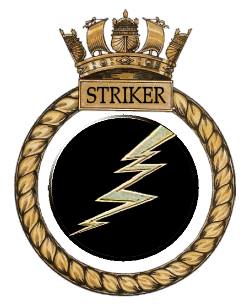 Description
Blazon (Heraldic description)
On a field of white, a pellet charged with a flash of lightning, from sinister chief, white.
A striker: One who hits sharply, as with a hand, fist, or a weapon
For explanations of heraldic terms see the Ship’s Badges page.
Motto:
None
|
|
Pennant Numbers:
D12 (Atlantic)
R315 /A460 (Pacific)
Battle Honours:
ATLANTIC 1943-44
ARCTIC 1944
NORWAY 1944
OKINAWA 1945
|
|
|
Specifications
Builder: Western Pipe &
Steel,
San Francisco, California
Completed by: Mare Island
Naval Shipyard, Vallejo California
Displacement: 14,170 tons
length (Overall): 486ft
Beam: 69ft 6in
Flight deck: 442ft x 80ft wood covered mild steel plate
Propulsion: 2 Foster Wheeler boilers; 1 x Allis-Chalmers
geared turbine driving 1 shaft
Speed: 18.5 knots
A/C Capacity: 20
Hangar: 262ft x 62ft x 18ft
A/C lifts: 2; aft 34ft long x 42ft wide; forward 42ft long x
34ft wide
Arrestor wires: 9 with 3 barriers
Catapult: 1 x H2 hydraulic
Armament: 2 single 4in USN Mk 9, 4 twin 40mm Bofors, 8 twin
20mm Oerlikon, 10 single 20mm Oerlikon
Crew Complement: 646
Commanding Officers:
Capt. E.W. Anstice RN as OIC
Aug 42 - Oct 42
Capt. F.M. Walton RN
Oct 42 - Dec 1943
Capt. W.P. Carne RN
[later Cdre. 2nd class]
Feb 44 - Feb 46
Squadrons:
824
Oct 43-Oct 44
Swordfish I
Sea Hurricane IIc
Wildcat V
898
May 1944
Wildcat V

Click here
to see more photos
|
|
|
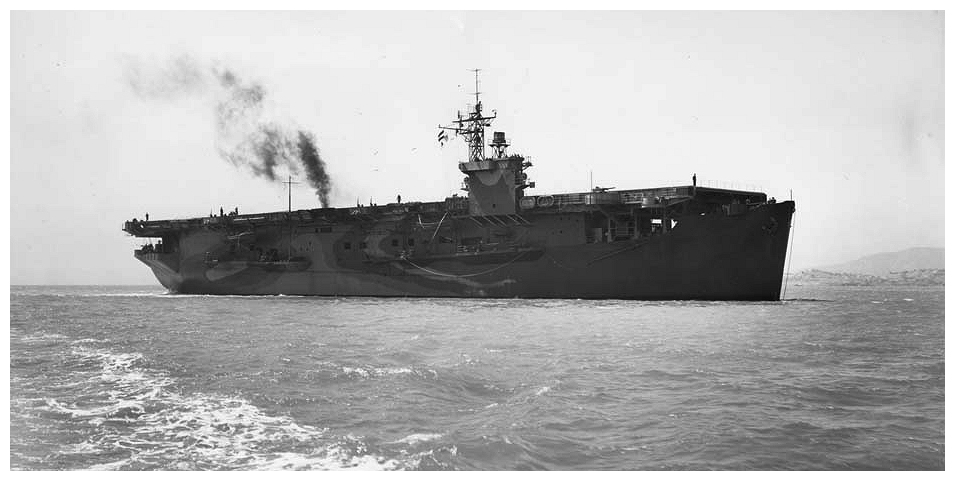 |
May 20th 1943, STRIKER in San Francisco Bay during
trials. Photo: US Navy Yard, Mare Island. |
Laid down December
15th 1941, by the Western Pipe and Steel Co., San Francisco,
California as Maritime Commission C3-S-A2 type freighter, hull
number 198, Western Pipe and Steel hull number 78; the hull was
purchased by the US navy to be the USS PRINCE WILLIAM AVG-19. She
was the fourth, and last vessel built for completion as an auxiliary
aircraft carrier by Western Pipe and Steel; all were transferred to
the Royal Navy, the other three were - ATTACKER (ex USS BARNES),
STALKER (ex USS HAMLIN), and
FENCER (ex USS CROATAN).
Whilst still under
construction it had been decided that AVG-19 was to be transferred
to the Admiralty on loan under the 'Lend-Lease' agreement upon her
completion. The name PRINCE WILLIAM was withdrawn before her launch
on May 7th 1942 (her USN designation changed to ACV-19 on August
20th 1942). On completion the hull was towed to the Mare Island
Naval Dockyard, Vallejo, California for fitting out as an escort
aircraft carrier; it was to take another year before she was
completed and ready for handing over to the Royal Navy.
The commissioning
crew for the new ship began to assemble in August 1942, Captain E.W.
Anstice RN was appointed as her senior officer. The advance party of
her crew sailed for New York the following month on board the troop
ship HMTS QUEEN ELIZABETH. They disembarked at New York on the east
coast of the United States, and were accommodated at RN Camp
Peekskill, New York State, while awaiting transport across the
continent to San Francisco on the west coast. Captain F.M. Walton RN
was also appointed to the ship on October 7th 1942 and was to be her
commanding officer upon commissioning (Captain Anstice became C.O.
of HMS
FENCER).
|
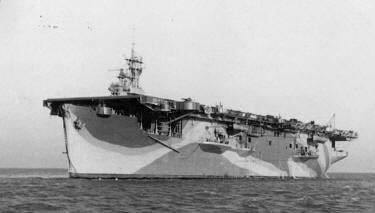 |
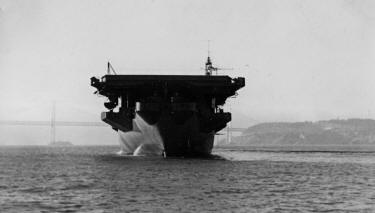 |
Sea trials: Striker in San Francisco bay
Photos: Richard Webb collection |
Transfer to RN and commissioning May 1943
On completion of defect rectification and final fitting out, ACV-19
was officially delivered to the US Navy at Mare Island on April 28th
1943. During April members of the crew received specialist training
in the use of ASDIC equipment at the U S Navy Patrol Force
Anti-Submarine Training Unit. ACV-19 was transferred to the United
Kingdom under the Lend Lease agreement and delivered on May 18th
1943 while alongside Pier 26 in San Francisco. She commissioned into
Royal Navy service as HMS STRIKER, pennant number D12, on that date,
Captain F.M. Walton RN in command.
Trials and maiden voyage May - June 1943
Sea trials began at 1540 on May 21st off San Francisco, and
calibration and speed trials commenced at 1535 on the 25th. While
alongside at Pier 26 she was stored in preparation for her maiden
voyage. She left San Francisco for the last time on May 29th to
conduct Gunnery exercises off the coast escorted by the USS PC-570,
firing her main armament at a target towed by the fleet tug USS
BAGADUCE. The Shoot which included night firings, completed at 2217
and STRIKER set course for Balbao, the Pacific entrance to the
Panama Canal.
She arrived at
Balbao on June 9th and transited the Canal to Cristobal on the
Atlantic side to await her escort to Norfolk Navy Yard. STRIKER
departed from Cristobal on June 14th to rendezvous with her escort,
the USS FRANKFORD at 0843. During the day the ship carried out an
anti-aircraft gunnery shoot on passage, firing at drogue targets
towed by US Navy aircraft.
Norfolk Naval Dockyard and Ferry load to UK June - July 194343
STRIKER arrived at Norfolk Navy Yard at 1900 on the 20th to undergo
the installation of additional equipment before beginning a short
work-up. The work included installing radar and radio equipment.
Repairs to main feed suction pipe and hangers, two reducing valves,
steering gear bushings, refrigerating units, F.G. transfer pump,
auxiliary feed pump, UC and VF equipment, battle announcing
equipment and general alarm circuit. Overhauled one train power
drive for heavy Anti-aircraft Machine Gun. Once this work was
completed STRIKER called at the US Naval Ammunition Depot, St.
Juliens Creek, Virginia, on June 23rd to embark small arms and gun
ammunition, returning to Norfolk on completion of loading.
Her dockyard work
and work-up complete STRIKER left the Norfolk Navy Yard at 1945 on
the 25th and moved to the Norfolk Naval Operating Base to embark
more stores and a cargo of Lend-Lease airframes for ferrying to the
UK. The Ferry load comprised of 10 Curtis Seamew, 10 Grumman Tarpon
(Avenger), 16 Grumman Martlet V (Wildcat), 10 Grumman Hellcat, 8
Vought Corsair. She sailed for New York on the 27th to join the
eastbound convoy HX246 for passage to the UK. Arriving at New York
on June 28th she joined her sister escort carrier SEARCHER which was
also waiting to join the convoy with a ferry load. Both carriers
were taken in hand by Bethlehem Steel Co. at 28th Street, Brooklyn
for voyage repairs which were completed the same day.
The two carriers
Sailed from New York with convoy HX246 on June 30th, this was a
large convoy consisting of 64 merchantmen and 19 escorts. After an
uneventful crossing STRIKER & SEARCHER escorted by ACANTHUS,
POTENTILLA & VERVAIN detached as fast section on July 11th, arriving
in Liverpool Bay on the 13th.
RN Dockyard Chatham, Modification to RN standards July - October 1943
On completion of unloading her ferry load STRIKER sailed from
Liverpool on July 15th for Chatham Dockyard, taking the northern
route passing Cape Wrath, May Island, and Flamborough Head, arriving
at Chatham on the 18th. Here she was to be modified to meet RN
standards before entering full service. This work included
installing British Type 79B aircraft warning and Type 272 surface
search radars, replacing the US 5in gun mountings with British
model, and modification of her petrol distribution system. The work
was to take three months; on completion of the dockyard work, she
was allocated to Western Approaches Command and sailed for the Clyde
on October 18th 1943.
On October 21st
STRIKER began Working up in the Irish Sea in preparation for
operational service as a Trade Protection Carrier. She had not yet
operated any aircraft so her flight deck equipment had to be put
through its paces and certified as safe; a number of different
aircraft types flew out to the ship to make arrested landings and
accelerated take-offs, including Martlet JV577 which carried out
catapult trials in STRIKER on October 24th. She was passed as
operationally fit to operate aircraft and was allocated number 824
Composite Naval Air Squadron. The squadron was equipped with 9
Swordfish II aircraft for anti-submarine defence and 6 Sea Hurricane
IIc fighters to provide protection against enemy aircraft. The
squadron flew out to the ship from RAF St. Angelo, County Fermanagh,
Northern Ireland on October 27th.
STRIKER spent the
next month conducting flying training and generally working up her
ship's departments in the Irish Sea training areas. On November 25th
she entered a Clyde shipyard for defect rectification before
becoming operational. There were two aircraft accidents during this
period, Swordfish LS285 piloted by Sub-Lt T.O. Hounslow RNVR
suffered aileron damage while being pushed aft, the tail ran over
the rounddown on November 20th. On the 29th Sub-Lt T.R.P. Mohan RNVR
was killed while flying in Sea Hurricane NF696, the aircraft spun
into the sea from 1,000ft.
On leaving the
dockyard she resumed flying training in readiness for her first
operational voyage. On December 9th Swordfish, LS319, flown by
Sub-Lt W.H. Thompson RNVR hit the barrier after catching a late wire
landing on.
Trade Protection Duties
The ship sailed from the Clyde on December 15th 1943 to join the 1st
Escort Group on convoy protection duties in the Atlantic. She
covered the passage of the out-bound combined convoy OS62/KMS36
between the 16th and 28th of December on passage from Liverpool
bound for Freetown and Gibraltar. Although 824 squadron was an
experienced unit the weather in the South-West Approaches and the
Atlantic made flying challenging:; during her first convoy escort
sortie the squadron had three landing accidents involving Swordfish;
on the 20th LS319 piloted by Sub-Lt W.A. Penlington RNVR, bounced on
landing, missing all the arrestor wires he opened the throttle and
attempted to climb away but hit the ship's radar aerials and crashed
into the sea. The crew was safely rescued. Sub-Lt S.W. Taylor RNVR
made a heavy landing on a pitching and rolling deck on Christmas
Eve, the undercarriage collapsed and the propeller hit the deck.
Sub-Lt J.C.H. Simpson RNVR also made a heavy landing on the 26th
when he broke the tail wheel of LS461.
At dusk on December
28th STRIKER was detached from the convoy to rendezvous with the
in-bound convoy SL143; she was escorted by the Royal Indian Navy
Sloops HMIS CAUVERY & KISTMA, they re-joined OS62/KMS36 once STRIKER
made contact with SL143 at 1200 on the 29th. It was the turn of the
fighter pilots to suffer damage landing on New Year's Eve, Sea
Hurricane NF699 floated into the barrier, causing damage to the
propeller, undercarriage & engine; this machine was piloted by
Sub-Lt P.A. Clarke RNVR but was usually the personal aircraft of
Major V.B.G. Cheesman Royal Marines and bore the name LIBBY on the
engine cowling. Major Cheesman also suffered a barrier crash on the
same day, flying in Sea Hurricane NF694 ('U'), he floated into the
barrier, causing damage to the propeller.
On January 1st 1944
STRIKER switched to cover the out-bound convoys OS63/KMS37,
remaining with them until the 7th. On that date she joined the
in-bound SL144, providing fighter and anti-submarine cover until
January 15th. During this period only one Sea Hurricane had a
barrier crash while another engaged the enemy; Lt C.J. Allen RNZNVR
on returning from a fighter patrol in JS333 ('S') on the 7th could
not lower his arrester hook and broke through no.1 barrier on
landing before being stopped by no.2 barrier. At 1300 on the 9th
Sub-Lt I.W. Hayes RNVR in Sea Hurricane NF670 ('Q') attacked a Ju290
which was shadowing the convoy, it dived away but he could not
pursue as his aircraft began vibrating due to a detached fuselage
panel so was forced to return to the ship.
STRIKER detached
from the convoy on the 15th and arrived back in the UK on the 17th
after 26 days at sea and entered a Clyde shipyard for a period of
defect rectification.
Operations with the 16th Escort Group
On completion of
her repairs STRIKER was allocated to work in company with her sister
ship
FENCER. The two carriers escorted by the Sloops CRANE and
WHIMBREL, exercised with the 7th Escort Group (7th E.G.) off the
Clyde on February 4th and 6th before sailing for Red Bay, Northern
Ireland to rendezvous with the 10th Escort Group (10th E.G.). During
night Deck Landing Training (DLT) on the night of the 5th Sea
Hurricane NE977 suffered extensive damage to its rear fuselage when
its tail hit the rounddown, the pilot, Sub-Lt L J.R. Harrison,
RNZNVR was OK.
On arrival at Red
Bay 10th E.G. comprising of the Frigates SPEY (8.0.), ROTHER, WEAR,
FINDORN, and LOSSIE, and 7th E.G. comprising the Sloops WOODCOCK,
CRANE, WHIMBREL with STRIKER and
FENCER formed 16th E.G, to operate
as an independent submarine hunting force off Western Ireland.
STRIKER was Senior Officer 16th E.G.
STRIKER and
FENCER
sailed from Red Bay on February 7th to cover the 60 ship Convoy
ON223, out-bound from Liverpool for New York, joining with the
convoy at 1400 on the 8th and provided anti-submarine sweeps until
the 15th before detaching to rendezvous with the in-bound convoy
HX278;
FENCER with Frigates SPEY ROTHER, WEAR, FINDWRN, and LOSSIE
joined as close escort while STRIKER with the Sloops WOODCOCK,
CRANE, and WHIMBREL operated as distant cover 50 - 100 miles out.
The force accompanied the convoy back to the UK, detaching on the
19th for the Clyde where STRIKER was to undergo another period of
defect rectification in a Clyde yard. There was only one recorded
flying accident during this period, Swordfish NE990, flown by Sub-Lt
A.F.N. Turvey RNVR, landed on the starboard side of the deck and its
starboard oleo was damaged when it went over the deck edge on the
17th.
|
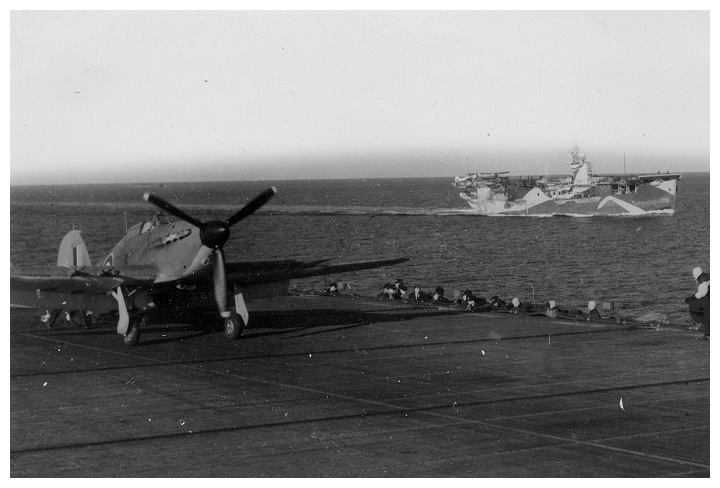 |
A Sea Hurricane of 824 squadron awaiting take off for a
patrol, STRIKER's sister CVE HMS FENCER is sailing in
formation with her. Photo: Richard Webb collection |
Her squadron was
disembarked to
RNAS Donibristle on February 19th for the duration of
period in dockyard hands, re-embarking on February 29th in
preparation for STRIKER's next operation.
STRIKER next sailed
to provide anti-submarine air cover for joint out-bound convoy
OS70/KMS44 during passage in the NW Approaches. She covered the
convoys from March 3rd to march 15th when the two convoys split.
On March 10th
STRIKER was detached with the Frigate BAYNTON and Corvette CLOVER to
conduct air attacks on U575 which at 0154 had torpedoed and sunk the
Corvette ASPHODEL west-northwest of Cape Finisterre. She was part of
escort for joint inward convoy SL150/MKS41 which was passing through
the same area. Only five survivors out of ASPHODELs crew of 97 were
picked up by CLOVER. After the attack the U-boat was hunted for 18
hours but managed to escape. On leaving OS70/KMS44 STRIKER switched
to cover Convoy KMS44G and escorted it into Gibraltar arriving there
on March 17th.
There were ninecrashes during this period; Sub-Lt H.G. Foster RNVR damaged the
fuselage of Swordfish LS461 on March 2nd when his machine ended up
in the barrier, and on the 8th Sub-Lt S.W. Taylor RNVR in Swordfish
NE980 floated into the barrier and the aircraft ended on its nose.
On March 9th three aircraft were damaged landing while on a pitching
deck; Sub-Lt H.G. Foster RNVR selected insufficient throttle when he
landed in Swordfish LS461, the hard landing damaging the aircraft's
stem post. Sub-Lt T.H. Talbot RNVR did the same in NF116 ('V'),
landed tail first damaging the stern post and tail oleo. The ship
pitched suddenly while Swordfish NE990 was over the stern and the
aircraft hit the rounddown and bounced into the barrier, the crew,
Sub-Lt D.A. Davies RNVR, Sub-Lt A. Boden RNZVRN and TAG T.W. Leggetter
were unhurt); the aircraft was beyond repair and after being
stripped of essential parts was jettisoned overboard. On March 10th
Sub-Lt D.A. Davies RNVR made a heavy landing in LS240 ('G'), in a
heavy swell, caught the last wire, and ended up on its nose.
LS461, which
had been repaired after the incident of March 9th, suffered engine
failure on the 13th and force landed on the sea, the pilot Lt. Cdr G.C. Edwards RCN and crew were picked up by FUSILIER. Also on the
13th Sea Hurricane JS292 bounced on landing, floated over all the
wires and ended up in the barrier and tipped on its nose, the pilot
Sub-Lt C.J. Allen RNZNVR was OK. The final incident was on March
16th when Sea Hurricane NF694 ('U'), flown by Petty Officer Pilot
P.H. Blanco RNVR, bounced landing on and crashed into the barrier.
On March 18th
STRIKER was allocated to the Home Fleet on loan for planned
operations in Norwegian waters. On the 21st while alongside in the
dockyard at Gibraltar, His Excellency the Governor General of
Gibraltar visited the ship and met the officers of the ship and her
squadron. STRIKER sailed the next day to rendezvous with Convoy
MKS43G, this rendezvoused with SL152 on March 23rd and the combined
convoy of 95 merchants and 11 escorts continued on to Liverpool,
arriving there on April 4th. STRIKER detached from the convoy on
April 2nd and proceeded to the Clyde for a Further defect
rectification period.
On making the
rendezvous 824 lost another Swordfish; LS456 stalled off the turn on
approach to the flight deck and crashed into the sea on the ship's
port quarter. The crew, Sub-Lt D.A. Davis & TAG T.W. Leggetter were
picked up unhurt by the Convoy Rescue Ship ABOYNE. Two days later on
the 25th Sea Hurricanes NF674 and JS333 (pilots unnamed) were
involved in a friendly fire incident when on a Cobra patrol around
the convoy, they attacked and shot down an American C-54 which was
not showing IFF while en route from Stephenville to Casablanca.
There was one final incident on the voyage home on the 26th;
Swordfish NF116 ('V'), flown by Sub-Lt J.L. Harrison RNVR, hit the
rounddown attempting to land on a pitching deck, the aircraft broke
its back. The damage was not repairable, the aircraft was probably
jettisoned.
Operations with the Home Fleet: April - July 1944
On leaving the
dockyard STRIKER sailed for Scapa Flow on April 17th to report for
temporary duty with the Home Fleet's Escort Carrier Squadron. On
arrival at Scapa on the 18th 824 squadron was briefly disembarked to
RNAS Grimsetter [1]
Note:
It is unclear when 824 NAS disembarked from, and re-embarked in, STRIKER during her time with the Home Fleet. Some commentators give dates that put them ashore at times when STRIKER was at sea on operations, and incident reports of flying accidents indicate aircraft were on board. Therefore this account assumes they remained embarked from April 21st 1944 until May 9th 1944.
where a further 3 Swordfish were also
received, increasing their number to 12 in readiness for her first
mission, operation PLANET. STRIKER sailed for the operation from
Scapa On Friday April 21st.
Operation PLANET
was a strike at the German Battleship TIRPITZ. The Force comprised
of ANSON (VA, 2IC Home Fleet), ROYALIST (Rear Admiral Escort
Carriers), VICTORIOUS, FURIOUS, EMPEROR, SEARCHER, STRIKER, KENT,
JAMAICA, URSA, UNDAUNTED, WAKEFUL, WIZARD, SERAPIS, JAVELIN, VENUS,
VIGILANT, SIOUX, ALGONQUIN, PIORUN, SWIFT, KEMPENFELT, and KELVIN.
The attack on TIRPITZ, which would have involved 40 Barracudas and
40 escort fighters, was cancelled because of bad weather conditions
on the 24th. The weather situation improved sufficiently for the
next round of operations, codenamed RIDGE ABLE and RIDGE BAKER to be
carried out on the 26th.
Operation RIDGE
ABLE involved the Fleet carriers VICTORIOUS and FURIOUS, and the
escort carriers EMPEROR, SEARCHER, PURSUER and STRIKER, to conduct
attacks on enemy shipping in the Bodo and Rorvik areas respectively.
The second stage had to be cancelled, again due to bad weather.
However RIDGE ABLE did result in three ships sunk off Bodo and a
fourth damaged. The force arrived back at Scapa on April 28th.
STRIKER and her squadron now prepared for the upcoming Operation
HOOPS.
Operation HOOPS
called for strikes by aircraft from EMPEROR, escorted by fighters
from SEARCHER, on shipping between Kristiansand North and Grosse,
together with oil tanks at Kjehn and a fish oil factory at Fossevaag.
STRIKER was to provide anti-submarine coverage. Ships of the Home
Fleet put to sea again on Sunday, May 7th, the force, which departed
Scapa at 0600, comprised ROYALIST Flagship Rear Admiral Escort
Carriers (R.A.E.C.), with JAMAICA, SEARCHER (joined at sea later
that day), EMPEROR, and STRIKER, escorted by KEMPENFELT, WAGER,
MARNE, SIOUX, ONSLAUGHT, and UNDAUNTED.
|
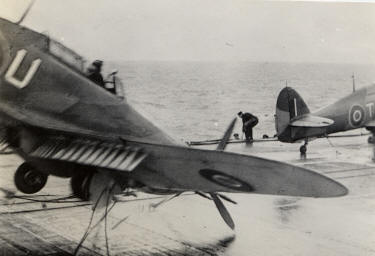 |
 |
Left: Sea Hurricane NF694 ('U'), caught as it is stopped in its
tracks by the barrier, causing damage to the propeller.
Right : Swordfish LS240 ('G') after landing in a heavy
swell, caught last wire, ending up on its nose. Photos: Richard Webb collection |
The Force arrived
in the flying off position at 0730 on the 8th May and two strikes,
each of 8 Hellcats escorted by 8 Wildcats, were flown off. The first
strike attacked a northbound convoy of 5 merchant ships with ten
escorts 15 miles south west of Kristiansand. One merchant ship was
probably damaged and two Wildcats were shot down. On returning the
strike was 'jumped' by a mixed force of 6 Me 109Gs and FW 190s. One
Hellcat was shot down, but the remaining Hellcats destroyed at least
1 FW 190 and 2 Me 109s. No convoy was sighted by the Second strike
so the Hellcats attacked the oil tanks at Khjen and a Herring Oil
factory at Fosnavaag. One merchant vessel was machine gunned off
Aalesund and two BV 138s shot down by the escorting Wildcats. One
Hellcat of the second strike which was damaged by flak was lost
after homing successfully back to the force. The force then withdrew
to the westwards and returned to Scapa at 1100 on May 9th. Striker's
squadron had an uneventful mission with no casualties or enemy
encountered; the squadron disembarked to
RNAS Hatston later that
day.
An additional squadron and a Royal visit
On May 11th STRIKER embarked the 10 Wildcats of
898 squadron to
provide Combat Air Patrols (CAP) during strikes on Norwegian coastal
targets. Normally embarked in SEARCHER the squadron had remained in
the Orkneys when SEARCHER withdrew for a period of defect
rectification in Rosyth Dockyard. They were on board when His Majesty King George VI
visited Scapa on the 11th; he inspected many of the ships assembled,
including STRIKER. 824 was embarked the following day when the ship
sailed from Scapa for Operation POTLUCK
Operation POTLUCK was another strike against shipping on the
Norwegian coast (between Rorvik and Frohavet) by the escort carrier
squadron; however the main object was to create a diversion for
Operation BRAWN which was being carried out simultaneously further
north. The Force comprised of ROYALIST (R.A.E.C.), SHEFFIELD,
EMPEROR, and STRIKER, screened by ONSLOW, OBEDIENT, URSA, BLYSKAWICA,
PIORUN, and WAKEFUL, left Scapa on May 12th and proceeded towards
the Norwegian coast, arriving in the flying off position at 1230 on
May 14th by which time German shadowers were in company.
After withdrawing to the westward, the force was attacked by 6 to
8 Me 110's. Gunfire from ROYALIST turned the formation away and Sea
Hurricanes from STRIKER's 824 squadron caused them to jettison their
bombs and veer off. On 15th May, the force closed the Norwegian
coast again and at 0425 a second strike of 8 bombers and 7 fighters
proceeded to attack the fish oil factory at Fosnavaag and two armed
coasters off the shore as no convoy was sighted. At 0600 on at
position 65°16' N 6°13' E one of the shadowing Focke-Wulf 200 Condors
was attacked by two of
898s Wildcats, JV510 ('7R') flown by Lt R. I.
Harrison RNZNVR, and JV496 ('6V') piloted by Lt W. I. Sheppard RNVR.
The aircraft was driven off and went into cloud with its port engine
smoking On returning from a CAP sortie Lt R.I. Harrison RNZNVR
flying JV460 ('7T'), landed on STRIKER with his hook up and was
stopped by the barrier. The strike returned without loss.
Unfavourable weather reports prevented any further strikes and the
force withdrew, arriving back at Scapa on May 16th. Only two
aircraft from 824 were damaged during operation POTLUCK. Both on the
14th; Sea Hurricane JS333 flown by Sub-Lt E.C. Gulden RNVR bounced
after catching a wire, causing port oleo damage, and Swordfish
NF161('N') flown by Sub-Lt D.A. Davies RNVR, landed tail down,
damaging the tail oleo and stem post.
The Force arrived back at Scapa at 0600 on Tuesday, 16th May
1944, The following day a detachment of 8 aircraft from 824 were put
ashore to
RNAS Hatston; they remained ashore till the 31st when they
were briefly re-embarked. A further detachment of 13 aircraft then
flew ashore to
RNAS Grimsetter on June 1st, re-embarking the next
day. It is assumed that
898 squadron remained aboard STRIKER at
Scapa until June 1st when they are recorded s disembarking to
RNAS
Hatston to await the return of SEARCHER from Rosyth.
It is unclear what duties STRIKER performed at Scapa over the
period between the completion of operation POTLUCK and her next
outing, operation WANDERERS in mid-June. It is possible she
conducted flying training and anti-submarine sweeps since there is
recorded aircraft activity in June which indicates she was
conducting flying operations, all relating to Sea Hurricanes. On
June 2nd Sub-Lt J.W. Hayes RNVR, in JS222 ('Q'), bounced on landing
and floated into the barrier, and on the 7th Sub-Lt E.C. Gulden RNVR
floated NF674 ('R') into the barrier. There were two more barrier
crashes on the 13th, Sub-Lt R.O. Steel RNVR in JS292 bounced overall
the arrester wires and flew into the barrier, damaging his propeller
and wheel fairings, and Sub-Lt P.A. Clarke RNVR put NF694 ('U') into
the barrier after his arrester hook jammed up. The Squadron
disembarked to
RNAS Hatston on June 14th, re-embarking on the 19th
Operation WANDERERS was designed to create a diversion in
Norwegian waters in the hope of influencing the German navy to
retain the large U-boat force already in that area, instead of
relocating them south to harass convoys in the English Channel
supplying the on-going operation OVERLORD. The force comprising of
ROYALIST (R.A.E.C.), SHEFFIELD, STRIKER, and
FENCER escorted by
MILNE, MUSKETEER, MARNE, METEOR, WAKEFUL, and WESSEX sailed from
Scapa 0600 on Tuesday June 20th1944. The operation was unsuccessful;
no U-boats were sighted. One Sea Hurricane, JS292, had a barrier
crash on the 22nd; the pilot Sub-Lt P.A. Clarke RNVR was unhurt.
Defect ratification and 824 Fighter flight is re-equipped
On arrival back at Scapa on the 25th the Swordfish flight was out
ashore to
RNAS Hatston and the ship sailed for the Clyde later that
day. On June 27th STRIKER entered a Clyde Shipyard for a short
defect rectification period. On leaving the yard STRIKER proceeded
to Belfast Lough where her remaining Sea Hurricanes were flown
ashore to
RNAS Eglinton on June 30th. The Sea Hurricanes were
withdrawn and 6 Wildcat Mk.5 fighters were issued.
|
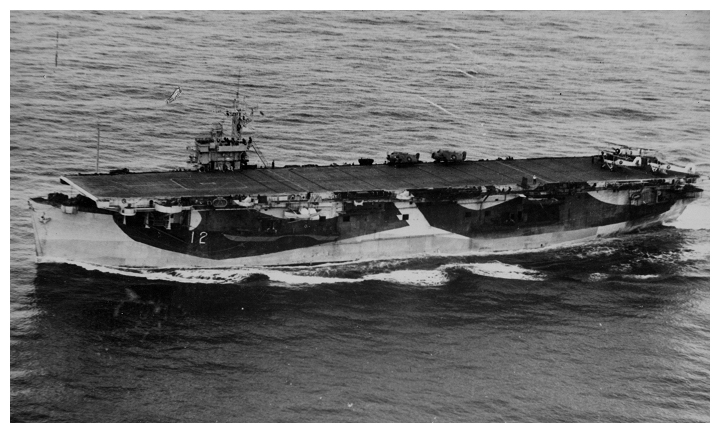 |
STRIKER on convoy protection duties in the Atlantic,
Wildcat and Swordfish aircraft of 824 squadron are on
deck. Photo: Richard Webb collection |
Detached operations: July - August 1944
STRIKER sailed from Belfast at 16:30 on July 10th, under orders to
assist in the search for German submarine U-11which had attacked
fishing trawlers in a position west of Cape Wrath. Her fighter
flight re-embarked that afternoon once she was underway.
She was to rendezvous with Force 34 which consisted of the
British built escort carrier
VINDEX, Frigates BULLEN, GOODALL,
MANNERS, Corvettes LAUNCESTON CASTLE, and PEVENSEY CASTLE, Canadian
Corvettes ARNPRIOR and ST. THOMAS. On reaching the rendezvous point
off the North Minches 824 Swordfish flight was landed on and STRIKER
relieved
VINDEX which returned to the Clyde for aviation petrol,
escorted by ARNPRIOR and LAUNCESTON CASTLE. She returned on July
13th escorted by the 3rd Escort Group Which relieved Force 34 on
station. This was to be the last protracted submarine hunt in the
European theatre of war conducted by escort carriers.
Weather conditions were poor; Coastal Command aircraft engaged in
the operation had been ordered to return to their bases because of
sea fog but carrier aircraft continued to fly and were often landing
on in visibility of less than 200 yards. On completion of the sweep
on July 27th STRIKER was detached on loan to Commander in Chief,
Plymouth for operation KINETIC. There is only one serious accident
recorded for this mission despite the extreme operating conditions;
on the 18th Swordfish NE980 caught the last wire, her arrester hook
pulled out and the machine broke through both barriers and crashed
into Swordfish NF237 parked forward. The pilot Sub-Lt H.G. Foster
was OK.
Operation KINETIC was an anti-shipping sweep in the Bay of
Biscay with the aim of the destruction of enemy merchant shipping
and escorts on the coastal convoy route between Gironde and Brest.
Force 26 comprising DIADEM (V.A. Tenth Cruiser Squadron) with
BELLONA, STRIKER and Canadian destroyers ASSINIBOINE, FOXHOUND,
RESTIGOUCHE and SKEENA of the tenth Destroyer Flotilla and three
ships of the Eleventh Escort Group sailed from Plymouth at 1838 on
July 30th and was at sea for four days operating off La Rochelle but
failed to locate the enemy. Force 26 arrived back at Plymouth on
August 3rd. There was only one aircraft crash during Operation
KINETIC, Sub-Lt M.E.R. Keates RNVR in Wildcat JV635 caught No.8
wire, continued into the barrier and damaged the propeller & tail
oleo on August 2nd.
Return to Scapa and Arctic convoy escort duty: August - September 1944
STRIKER arrived
back at Scapa on August 7th and was allocated to form part of the
escorting force for the round-trip artic convoy code named operation
VICTUAL.
Operation
VICTUAL was to provide safe passage of convoys JW59 and RA59A
between the United Kingdom and North Russia. The convoys were to be
protected by a force comprised of
VINDEX (V.A. Tenth Cruiser
Squadron) STRIKER, JAMAICA, Destroyers MILNE, MARNE, METEOR,
MUSKETEER, CAPRICE, Twentieth Escort Group, Destroyer WHITEHALL,
Frigate LOCH DUNVEGAN, , Sloops CYGNET, PEACOCK, KITE, KEPPEL,
MERMAID, Corvettes BLUEBELL, CHARLOCK, DIANELLA, OXLIP, and
HONEYSUCKLE.
The convoy of 33
ships of JW59 left Loch Ewe on August 15th with 12 E.G.
VINDEX with
STRIKER and JAMAICA, escorted by VOLAGE, ALGONQUIN, VERULAM, VIRAGO,
SCOURGE, WHIRLWIND, and WRANGLER left Scapa on the 16th to
rendezvous with the convoy on the 17th. On passage, 23 U-boats were
sighted though none was allowed closer than 40 miles from the
convoy. The two carriers flew 444 hours in the U-boat area and made
14 attacks at distances between 50 and 75 miles from the convoy.
On the 20th another
group joined the convoy; this was eight Destroyers being delivered
to the Russian Navy under the Lend-Lease agreement, they were USSR
ZARKIJ ex BRIGHTON, USSR DERZKIJ ex CHELSEA, USSR DEJATELNYJ ex
CHURCHILL, USSR ZOSTKIJ ex GEORGETOWN, USSR ZGUCHIJ ex LEAMINGTON,
USSR DRUZNYJ ex LINCOLN USSR ZIVUCHIJ ex H RICHMOND, and USSR
DOBLESTNYJ ex ROXBOROUGH accompanied by the British Destroyer
CASSANDRA. More escorts also joined on the 20th, the Battleship USSR
ARCHANGEL (ex ROYAL SOVEREIGN) flying the flag of Vice Admiral
Levchenko accompanied by the British Destroyers SCORPION, SERAPIS,
and CAMBRIAN. In addition, ten Russian M.L.'s also sailed with the
convoy.
No merchant ships
were lost, but the Sloop KITE of the 22nd EG was torpedoed and sunk
by 2 torpedoes from U-344 on August 21st. A shadowing flying boat, a
BV 138 was shot down by STRIKER's Wildcats At 0410 on August 22nd;
JV476 ('Z') flown by Sub-Lt T.D. Lucey RNVR, and JV589 ('R') flown
by Sub-Lt R.I.C. Dibben RNVR, shot down a black Bv138 which dived
vertically into the sea, no survivors were seen, at position 74°55' N
13°50' E. Later the same day one of
VINDEX's Swordfish sank U-344.
The next day another Swordfish from
VINDEX located U-354, attempting
to approach the convoy to the north of North Cape, she was sunk by
the Destroyer KEPPEL, Frigate LOCH DUNVEGAN, and Sloops MERMAID and
PEACOCK of the 20th EG. Russian fighter cover was available from the
morning of August 24th. There were no casualties to aircraft. JW59
arrived at Kola Inlet on the 25th with all 33 merchant ships The
Russian warships arrived at Kola on the 24th having left the convoy
on the 23rd.
While at anchor in
the Kola Inlet awaiting the assembly of the return convoy STRIKER
played host to British and Russian sailors and Naval Officers, when
a concert was held in the hangar; the entertainment included
performances accompanied by a string quartet.
The return convoy
RA59A sailed from the Kola Inlet three days later for the return
voyage to Loch Ewe. This was a much smaller convoy of only 9
merchant ships. Swordfish from
VINDEX attacked the only U-boat
sighted, on September 2nd with rockets and depth charges; it was
destroyed by the Destroyers KEPPEL and WHITEHALL, and Sloops
PEACOCK, and MERMAID. RA59A arrived at Loch Ewe on September 5th.
VINDEX, STRIKER, JAMAICA, and the Fleet destroyers arrived at Scapa
on the 6th.
There were only
three flying incidents during the passage of JW59 and RA59A; shortly
after sailing from Scapa a serious crash occurred which resulted in
a fatality, Lt R. Moss RNVR in Wildcat JV442 landed on STRIKER but
the arrester wire broke, the aircraft broke through both barriers
and into the tail of Swordfish LS231 in the forward aircraft park,
FX 561956 Air Mechanic (Airframes) Harry Barrow was killed, possibly
by the parted wire. On August 21st Sub-Lt C.G. Rowe RNVR made a
heavy landing in Swordfish HS406 which damaged the starboard oleo
and lower wing. The third was on September 1st, Swordfish LS231
('D') missed all the arrester wires and flew into the barrier, on
coming to an abrupt stop the engine fell out. The pilot Sub-Lt J.C.
Simpson and crew were OK.
|
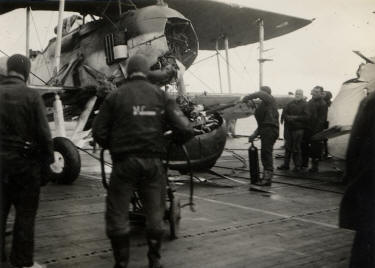 |
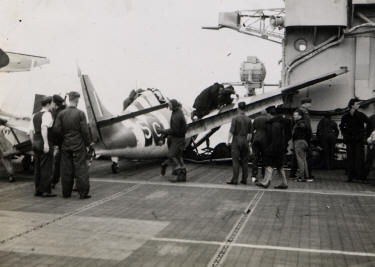 |
Left: Swordfish LS231 ('D') with its engine on the deck
after being stopped by the barrier. Right Wildcat
JV442 'S' after the arrester wire broke, the
aircraft broke through both barriers, hit the tail of
Swordfish LS231 in the forward aircraft park and swung
to starboard, hitting the Island.. Photos:
Richard Webb collection |
STRIKER and
VINDEX
sailed from Scapa at 1600 on the 6th for the Clyde, escorted by
VIRAGO and SIOUX as far south as the North Minches, and arrived on
the Clyde the following day. Here STRIKER made preparations for her
next mission. She sailed again at 0730 on Wednesday, September 13th
1944 to rendezvous with the British built escort carrier
CAMPANIA in
the Mull of Kintyre, escorted by KEMPENFELT and OBEDIENT on passage
to Scapa.
CAMPANIA and STRIKER arrived at Scapa on September 14th
Operation
RIGMAROLE was the codename for the next Arctic convoy escort
mission to the Kola Inlet and back with convoys JW60 and RA60. The
escort force comprised of the Battleship RODNEY, Cruiser DIADEM and
Escort Aircraft Carriers
CAMPANIA (R.A. First Cruiser Squadron) and
STRIKER screened by Destroyers MARNE, METEOR, MILNE, MUSKETEER,
VENUS, SAUMAREZ, SCORPION, VERULAM, VIRAGO, VOLAGE, ALGONQUIN (RCN)and
SIOUX (RCN)
The 30 merchant
vessels of JW60 departed from Loch Ewe on September 15th escorted by
the ships of the 7th E.G., Destroyers BULLDOG, CYGNET, WHITEHALL,
Frigate KEPPEL, Corvettes BAMBOROUGH CASTLE, and ALLINGTON CASTLE.
The carriers and their escorts sailed from Scapa on the 16th to
rendezvous with the convoy on the 17th. JW60 arrived at Kola Inlet
on September 23rd without loss, there was little enemy contact due
to bad weather conditions.
The return convoy
RA60 sailed from the Kola Inlet four days later on the 27th for the
voyage to Loch Ewe. The convoy contained 32 merchant ships.
Swordfish from both carriers flew night anti-submarine patrols on
the homeward voyage.
Two merchant
vessels were torpedoed and sunk by U-310 on the 29th, the American
S.S. EDWARD H CROCKETT was abandoned by her crew and was later
scuttled by gunfire from MILNE, and the British S.S. SAMSUVA, she
broke in two after being hit by a torpedo but remained afloat and
had to be scuttled by gunfire from MUSKETEER and BULLDOG. On the
30th Swordfish aircraft F of
CAMPANIA's 813 Squadron attacked and
sank U-921 in position 72°32' N 12°55' E, west of Bear Island. The
carriers detached from the convoy on October 3rd, arriving at Scapa
on the 4th. Convoy RA60 arrived at Loch Ewe on October 7th.
824 squadron had
three landing incidents on the return voyage, all on the 29th;
Wildcat JV634 flown by Sub-Lt B.J.C. Dibben RNVR hit the rounddown,
the arrester hook snapped and the aircraft flew into the barrier.
Swordfish NE988 flown by Sub-Lt P.G. Comber RNVR had Barrier crash,
while the undercarriage of Swordfish DK762 collapsed on landing and
the engine fell out, the pilot Sub-Lt S.W. Taylor and crew were OK.
Allocated to the British Pacific Fleet: Ferry voyage to Australia
STRIKER arrived on
the Clyde on October 6th for a period of defect rectification; 824
squadron parted company with STRIKER after this operation, the
squadron disembarked to
RNAS Machrihanish. The short time in
dockyard hands was to repair damage incurred during her last voyage
and to prepare her for her new role as part of the 30th Aircraft
Carrier Squadron (30 ACS) which was to form as part of the new
British Pacific Fleet for operations in the South West Pacific.
On October 25th
STRIKER was berthed at King George V dock, Liverpool alongside
FENCER for aircraft to be loaded aboard as deck cargo by floating
crane. The aircraft were Mosquito B.IVs belonging to 618 Squadron
RAF and these, together with their equipment and stores, were to be
ferried to Australia aboard the two carriers on their voyage to join
the British Pacific Fleet. The personnel of 618 Squadron embarked on
October 30th, half in STRIKER the other half in
FENCER.
618 Squadron was a
specialist unit operating 24 Mosquito B.IVs and 3 Mosquito PR.XVI
for the delivery of the 'Highball' anti-shipping bouncing bomb. By
the time this unit was ready German targets were scarce so in July
1944 it was allocated for the Pacific theatre for operations against
Japanese targets. The aircraft were carrier capable and had arrestor
hooks and strengthened undercarriage legs but no record of any of
their Mosquitoes performing ship board deck landings are known. The
squadron's pilots were trained in the art of deck landing flying
Barracudas on HMS RAJAH.
The two carriers
departed the Clyde at 14:30 on October 31st bound for Gibraltar,
escorted by KELVIN, MARNE, and MUSKETEER. The ships arrived at
Gibraltar at 0100 on November 5th. After refuelling they continued
on to Alexandria, UNDAUNTED joining the escort. They arrived at
Alexandria on November 11th where the three destroyers that had
escorted her from the UK detached to join the Mediterranean Fleet.
After transit of the Suez Canal STRIKER,
FENCER and UNDAUNTED took
passage down the Red Sea to call at Aden to refuel before crossing
the Indian Ocean, they arrived at Trincomalee, Ceylon on November
22nd.
|
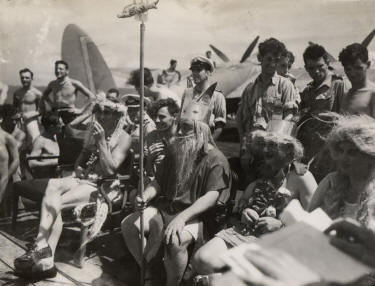 |
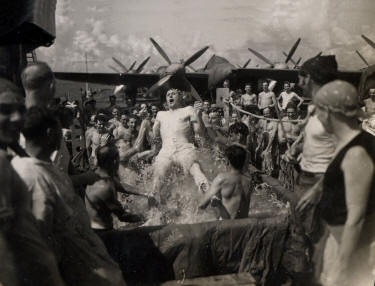 |
Crossing the line: King Neptune and his party watch as
those who have not crossed the equator before are
initiated intro the order of the Shellbacks.
618 squadron Mosquitoes are clearly visible. Photos:
Richard Webb collection |
After a short time
spent in Ceylon both STRIKER and
FENCER sailed from Colombo on
December 10th 1944 this time in company with the cruiser SWIFTSURE
(flagship of Rear-Admiral E. J. P. Brind, CB, CBE, commanding Fourth
Cruiser Squadron) and their escort, the destroyers KEMPENFELT
(Captain D, 4th Destroyer Flotilla), WESSEX, and WAKEFUL. Once at
sea they were joined by the CVEs
ATHELING and
BATTLER, the cruiser HMNZS ACHILLES and destroyers WAGER and WHELP, to proceed in convoy
to Australia. Most of the destroyers returned to Trincomalee on the
11th and on the 16th the cruisers SWIFTSURE and ACHILLES parted
company with the carriers and went on ahead to Fremantle.
From Fremantle
ATHELING and
BATTLER continued on to Sydney before crossing the
Pacific for a period of duty on loan to the US Navy.
FENCER and
STRIKER sailed for Melbourne after refuelling; arriving there on
December 23rd to unload 618 Squadron and their aircraft at Nelson
Pier, Williamstown, Victoria. Both ships then proceeded to Sydney to
join the BPF, arriving there on January 7th 1945.
|
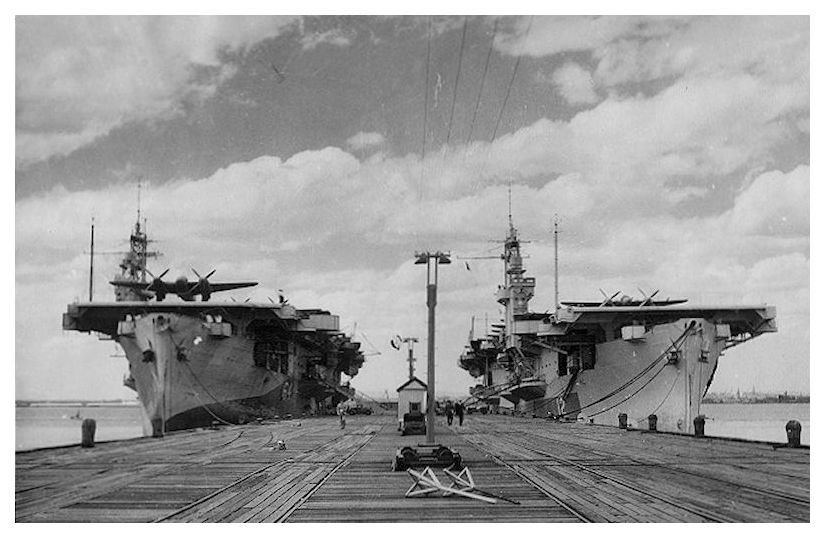 |
Alongside at Williamstown, Victoria, FENCER (Left)
&STRIKER (Right) wait to to unload the men and aircraft
of 618 squadron RAF before proceeding on to Sydney. Photo: Richard Webb
collection |
Operations with the BPF: January - August 1945
During February
STRIKER was employed on Deck Landing Practice (DLP) duties operating
in the Jervis Bay area for squadrons ashore at
RNAS Nowra (MONAB 1).
1836 squadron's Corsairs visited the ship on several occasions and
two serious landing accidents occurred during this month. The first
involved Sub Lt H West RNVR who flew JT538 into the barrier on the
12th. On the 21st, Sub Lt H Griffin RNVR overturned JT419 on landing
in a spectacular accident which was caught on camera.
At the end of
February STRIKER was assigned as a forward area replenishment
carrier; in this role she would not carry any operational squadrons
but carried replenishment loads of spare airframes for issue to
other carriers whilst at sea. In this role she operated as a part of
'the Air Train', the aviation logistic support element of the
British pacific Fleet's logistics life-line -the Fleet Train-. This
organisation consisted of a collection of merchant and military
vessels which supplied the fleet with fuel, food ammunition and
stores; the main base was at Sydney with forward bases at Manus in
the Admiralty Islands and Leyte in the Philippines, its vessels
operating over a distance of some 2,500 miles each way.
STRIKER spent the
first week of March loading equipment, spares, airframes and
passengers in preparation for her first voyage to the forward base
at Manus. On March 4th she embarked elements of MSR 3 (Maintenance,
Storage & Reserve unit No. 3) from
RNAS Bankstown (HMS NABBERLY).
This unit was added to STRIKER's air engineering department to
provide additional capabilities and maintain a reserve pool of ready
to issue airframes afloat. This was a stop gap measure imposed
because the proposed 'Forward Aircraft Pool' that was to be
established ashore in the forward area had not yet been set up, and
no suitable location for it had yet been found. Other elements of
MSR 3 were embarked in the maintenance carrier UNICORN to bolster
her engineering department and provide a second pool.
STRIKER became the
flagship of the 30th Aircraft Carrier Squadron (30 ACS), on March
4th; her commanding Officer, Captain W .P. Carne, receiving promotion
to the rank of Commodore 2nd Class and Officer in command 30 ACS. On
March 7th 1945 STRIKER sailed from Sydney on passage to Manus,
arriving there on the 13th.
STRIKER and the
other escort carriers of 30 ACS were issued two new pennant numbers
for operations in the Pacific theatre, STRIKER was allocated R315
and A460; she wore R315 for operations as a forward area
replenishment carrier. The second number was to be worn when
operating in the ferry carrier role (there is photographic evidence
that she did wear A46, she is pictured alongside at Circular Quay in
Sydney).
|
 |
March 1945 Ferry load to Manus: Striker on passage from
Sydney to Manus transporting a ferry load for
distribution to the carriers of the 'air train' . |
ICEBERG One Replenishment operations: March - April 1945
STRIKER was to be employed as a forward area replenishment carrier and would only carry replenishment loads of spare airframes for issue to other carriers whilst at sea as a part of the Air Train, the aviation logistic support element of the British pacific Fleet's logistics life-line 'the Fleet Train'. This was a collection of merchant and military vessels which supplied the fleet with fuel, food, armaments and other stores. Based in Sydney, with forward bases at Manus in the Admiralty Islands and Leyte in the Philippines, the Fleet Train operated over a distance of some 2,500 miles each way.
At this time the Air Train comprised of the CVEs
STRIKER,
SPEAKER, and
SLINGER, the maintenance carrier
UNICORN, the Aircraft Component Repair Ship
DEER SOUND and the Air Stores Issue Ship
FORT COLVILLE. STRIKER and SLINGER were employed as forward area replenishment carriers (later joined by
CHASER, and
ARBITER), SPEAKER (1840 Sqn flying Hellcats) and later
RULER (885 Sqn flying Hellcat and Avenger) as CAP (Combat Air Patrol) & ASP (Anti-Submarine Patrol) carriers,
UNICORN,
DEER SOUND and
FORT COLVILLE operated at Manus and Leyte as required, and later
PIONEER was based at Manus on arrival on station. The replenishment carriers embarked mixed loads for transport to the replenishment area, numbers varied from 14 - 25 aircraft. A typical load for ICEBERG One was 9 Seafires, 7 Avengers, 6 Corsairs, 1 Hellcat, and 1 Firefly but composition was adjusted when attrition of certain types exceeded estimates or available spare airframes were in short supply.
STRIKER and
SPEAKER sailed from Sydney in company with other ships of the Fleet Train, including FORT COLVILLE, on March 9th 1945 escorted by the frigate AVON and sloop CRANE, they arrived in Seeadler harbour on March 13th to join other elements of the Fleet Train assembling there.
After restoring and fuelling advance elements of the Fleet Train sailed from Manus beginning on March 17th in order to have a Tanker Group in position for the BPF to top up with fuel at the last prudent moment before embarking on the forthcoming strikes against the island of Okinawa 'Operation Iceberg I'. The ships sailed in two groups;
the tankers SAN AMBROSIO, CEDARDALE and SAN ADOLPHO escorted by the Slops CRANE and PHEASANT and the frigate FINDHORN, sailed first on March 17th followed by the faster carriers STRIKER and SPEAKER escorted by the destroyers KEMPENFELT and WHIRLWIND departing on the 19th.
Upon rendezvousing the two groups were formed into Task Units TU 112.2.1 and TU 112.2.5, and proceeded directly to the prearranged replenishment area. The ships of the BPF ( Task Force 113
The Brutish Pacific Fleet Task Force 113 comprised:
1st Aircraft Carrier Squadron INDOMITABLE (Flag 1st Aircraft Carrier Squadron (1ACS), 857 Avenger, 839 and 1844 Hellcat), ILLUSTRIOUS (854 Avenger, 1830 & 1833 Corsair), INDEFATIGABLE (820 Avenger, 1770 Firefly, 887 & 894 Seafire), VICTORIOUS (849 Avenger, 1834 and 1836 Corsair,);
1st Battle Squadron;
HMS KING GEORGE V (Flagship V.A.B.P.F. Vice Admiral Sir H. Bernard Rawlings, KCB, OBE), and HMS HOWE;
4th Cruiser Squadron;
SWIFTSURE, (Flagship CS 4 Rear Admiral E. J. P. Brind, CB, CBE), ARGONAUT, BLACK PRINCE, EURYALUS, (Flag of Rear Admiral (D) Rear Admiral J. H. Edelsten, CB, CBE), GAMBIA;
4th Destroyer Flotilla:
QUICKMATCH (Capt. D:4), QUIBERON, QUEENBOROUGH, QUALITY;
25th Destroyer Flotilla;
GRENVILLE (Captain D 25) ULSTER, UNDINE, URSA, URANIA;
27th Destroyer Flotilla
KEMPENFELT (Captain D 27), WAKEFUL, WHIRLWIND, WHELP, and WESSEX.
(Note: KEMPENFELT (Capt. D.27) was attached to TU 112.2.5, the group remaining in the replenishing area. WHIRLWIND and. WESSEX were attached to TU 112.2.1 and TU 112.2.2 respectively, the Tanker Groups proceeding between Leyte and the replenishing area.
) had arrived at Ulithi Atoll 1,300 miles north west of the Admiralty Islands on March 18th and after refuelling and taking on ammunition and stores the British pacific Fleet was redesignated Task Force 57 on March 23rd under the operational control of Admiral Raymond Spruance USN, C-in-C US Fifth Fleet TF 57sailed from Ulithi at 06:30 on March 23rd 1945, for operations.
Replenishment period 1, March 25: The British Pacific Fleet (now
re-designated Task Force 57), sailed from Ulithi at 06:30 on March
23rd 1945 for operations as part of the U.S. Fifth Fleet under
Admiral Raymond Spruance U.S.N. They met with the LSG The Logistic Support Group comprised of two or more Task Units of Task Group 112; one Task Unit provided air cover for the LSG and remained in the replenishment area.
LSG air cover TU 112.2.5, the CVE SPEAKER, (1840 sqn Hellcats for Combat Air Patrol duties over the LSG), escorted by the Sloop PHEASANT and Destroyer KEMPENFELT.
Replenishment group TU 112.2.1, the CVE STRIKER (with 18 replacement aircraft), Tankers SAN AMBROSIO, CEDARDALE and SAN ADOLPHO escorted by the Sloop CRANE, Frigate FINDHORN, and Destroyer WHIRLWIND.
at 06:00 on March 25th, at replenishment area ANT, (18° 3o’N 129° 08’E), for a short replenishment at sea which included the issuing of 4 replacement aircraft from STRIKER and topping off fuel tanks. SPEAKER provided Combat Air Patrols (CAP) Hellcats over the LSG. Fueling was completed by 15:30.
T F57 joined US
Task Force 58 on the 26th for joint attacks on islands of the
Sakishima-Gunto group in support of preparations for US landings on
Okinawa. This was the first of 12 strike sorties against Japanese
airfields on the Islands of the Sakishima-Gunto group in operation
ICEBERG One. Because of the long distances involved between the
operational area and the nearest forward base, all replenishment had
to be done at sea; TF57 was operating a strike cycle of 2 days on
station followed by 2-3 days of replenishment.
With the departure of the fleet the ships of the logistic support group moved to refuelling area MIDGE on the 28th. There were three areas used for fuelling, each was a rectangular area which covered 5000 square miles of ocean east of Luzon, their code names were all called after insects; each area was 50 miles to the south and 100 miles west of' the following positions – 'COOTIE' 21° 52’ N 129° 24’ E; 'MIDGE' 19° 55’ N 129° 40’ E; and ‘MOSQUITO' 20° 17’ N 125° 22’ E. The nominated area changed from one replenishment period to the next.
Replenishment period 2, March 28 - 30: On withdrawing from the operational area
at dusk on March 27th TF57 met the LSG
For the second replenishment the LSG comprised:
LSG air cover TU 112.2.5, the CVE SPEAKER, (1840 sqn Hellcats for Combat Air Patrol duties over the LSG), escorted by the Sloop PHEASANT and Destroyer KEMPENFELT.
Replenishment group TU 112.2.1, the CVE STRIKER (with 14 replacement aircraft), Tankers SAN AMBROSIO, CEDARDALE and SAN ADOLPHO escorted by the Sloop CRANE, Frigate FINDHORN, and Destroyer WHIRLWIND.
in Area Midge One at 07:30 on
March 28th, a rectangular area east of Luzon which covered 5000
square miles of ocean, and began refuelling. STRIKER issued 13
replacement aircraft and recovered 3 'flyable duds' (flyable but
unserviceable aircraft), in addition she transferred a replacement
Avenger aircrew to 854 Squadron aboard ILLUSTRIOUS. Her stock of
spare aircraft exhausted STRIKER departed for Leyte in the afternoon
of the 29th, escorted by CRANE and WHIRLWIND. Replenishment was
complete by mid-afternoon on March 30th and TF57 withdrew.
Replenishment
period 3, April 3 - 5:
SLINGER was
on station with the LSG
For the third replenishment the LSG comprised:
LSG air cover TU 112.2.5, the CVE SPEAKER, (1840 sqn Hellcats for Combat Air Patrol duties over the LSG), escorted by the Sloop PHEASANT and Destroyer KEMPENFELT.
Replenishment group TU 112.2. 2, the CVE SLINGER (with 24 replacement aircraft), Tankers AASE MAFRSK, ARNDALE, WAVE KING escorted by the Sloop WOODCOCK, Frigate PARRET, and Destroyer WESSEX. And TU 112.2. 3, Tankers DINGLEDALE and WAVE MONARCH escorted by the Frigate AVON and Sloop WHIIMBREL.
she issued 22
of her 25 replacement aircraft to the fleet carriers and recovered 2
'flyable duds'. STRIKER sailed from Leyte at 12:00 on the 4th to return to the replenishment area with a smaller replacement load of 14 aircraft.
Replenishment period 4, April 8 - 9:
At 06:00 on the 8th TF57 met the LSG
For the fourth replenishment the LSG comprised:
LSG air cover TU 112.2.5, the CVE SPEAKER, (1840 sqn Hellcats for Combat Air Patrol duties over the LSG), escorted by the Sloop PHEASANT and Destroyer KEMPENFELT.
Replenishment group TU 112.2.1, the CVE STRIKER (with 14 replacement aircraft), Tankers ARNDALE, DINGLEDALE, SAN AMBROSIO, and SAN ADOLPHO escorted by the Sloop CRANE, Frigate FINDHORN, and Destroyer WHIRLWIND.
in replenishment area COOTIE One, U.S. Task Group 52.1 having taken over the strike duty.
SPEAKER provided CAP for the
Fleet Train while
STRIKER
provided replacement aircraft and aircrews; she issued 13
replacement aircraft and recovered 4 flyable 'duds' and supplied one
Avenger crew to 854 squadron. Replenishment was completed by the afternoon of the
9th and TF 57 left Cootie One to return to Sakishima.
Replenishment period 5, April 14 - 15: At 06:30 on April 14th the Fleet made contact with LSG
For the fifth replenishment the LSG comprised:
LSG air cover TU 112.2.5, the CVE SPEAKER, (1840 sqn Hellcats for Combat Air Patrol duties over the LSG), escorted by the Sloop PHEASANT and Destroyer KEMPENFELT.
Tanker Group TU 112.2. 2, Tankers ARNDALE, AASE MAERSK, CEDARDALE, SAN ADOLPHO, SAN AMBROSIO, and WAVE KING escorted by the Sloop WOODCOCK, Frigate PARRET, and Destroyer WESSEX.
Note: The CVE SLINGER should have been on station as the replenishment carrier but had been withdrawn to return to Australia for mechanical repairs; no other CVE was on station to take her place.
in
position Cootie One. There were no replacement airframes available when the fleet next withdrew to replenish; SLINGER had suffered mechanical problems on passage back to Manus to reload. The issue meant she could no longer operate aircraft; she could only safely achieve 12 knots and was ordered back to Australia for repairs. However, the carrier FORMIDABLE, with destroyers KEMPENFELT and WESSEX were on station and joined Task Force 57 relieving ILLUSTRIOUS which sailed for Leyte at 17:55 screened by URANIA and QUALITY. Replenishment continued on the 15th.SPEAKER provided CAP. The lack of replacement airframe was eased by FORMIDABLE which was at full strength carrying 848 Squadron’s 18 Avengers along with
1841 and
1842 Squadrons - each with 18 Corsairs.
Replenishment period 6, April 18 - 19: During the 18th and 19th the fleet refuelled from the LSG
For the fifth replenishment the LSG comprised:
LSG air cover TU 112.2.5, the CVE SPEAKER, (1840 sqn Hellcats for Combat Air Patrol duties over the LSG), escorted by the Sloop PHEASANT and Destroyer KEMPENFELT.
Tanker Group TU 112.2. 2, Tankers ARNDALE, AASE MAERSK, CEDARDALE, SAN ADOLPHO, SAN AMBROSIO, and WAVE KING escorted by the Sloop WOODCOCK, Frigate PARRET, and Destroyer WESSEX.
No replenishment carrier on station due to a shortage of replacement aircraft.
tanker group, SPEAKER again providing CAP fighters. No replacement aircraft were issued during this period. At dusk on the 19th TF 57 withdrew to be back on station at dawn on April 20th to carry out one their twelfth and final strike day of ICEBERG One.
TF57 undergo repairs and replenishment at Leyte April 23rd - May 1st: 32 days after sailing from Ulithi the Fleet anchored in San Pedro Bay, the Philippines at 12:45 on April 23rd close to the ships of the waiting Fleet Train. Task Force 57 had spent 26 of these days on operations, and had completed 12 strike days. During this period 71 enemy aircraft were destroyed, 33 in the air and 38 on the ground; 52 were damaged, 2 in the air and 50 on the ground. TF57 lost 19 aircraft to enemy action 2 to ‘friendly fire’ and at least 37 were put out of action through operational incidents. Allied casualties were 16 pilots and 13 aircrew. The replenishment carriers issued 52 replacement airframes; STRIKER 30 & SLINGER 22. Only 9 flysble duds were received; ; STRIKER 7 & SLINGER 2.
|
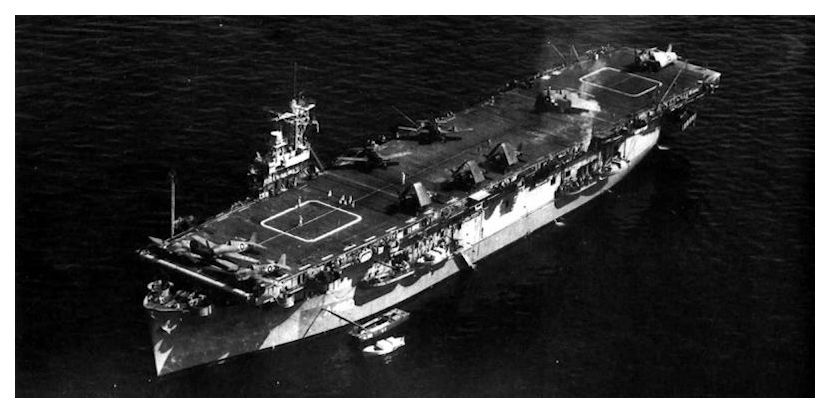 |
STRIKER at Leyte, the Philippines, April 1945 She is
carrying a variety of different aircraft types in the
role of Replenishment Carrier Photo © Andrew Toppam |
ICEBERG Two Replenishment operations: May - August 1945
After eight days of
repair and replenishment Task Force 57 sailed from Leyte on at 06:30
on May 1st to return to their operational area off the
Sakishima-Gunto group for a second series of 12 strike days.
Replenishment period 7, May 3:
The Fleet refuelled from the LSG
For the seventh replenishment the LSG comprised:
LSG air cover TU 112.2.5, the CVE RULER (replacing SPEAKER, operating885 Sqn - 12 Hellcats, 4 Avengers and 8 Corsairs - for Combat Air Patrol an Anti-Submarine duties covering the LSG), escorted by the Sloop CRANE.
Tanker Group TU 112.2. 1, Tankers CEDARDALE SAN ADOLPHO, and SAN AMBROSIO escorted by the Frigate AVON and Sloop WHIIMBREL.
No replenishment carrier on station.
in Area MOSQUITO One during the day on
may 3rd to top off their tanks before departing for the flying off position. No aircraft were
issued.
Replenishment period 8, May 6 - 7: At 06:30 on May 6th TF 57
met up with the LSG
For the eight replenishment the LSG comprised:
LSG air cover TU 112.2.5, the CVE RULER (885 Sqn - 12 Hellcats, 4 Avengers and 8 Corsairs - for Combat Air Patrol an Anti-Submarine duties covering the LSG), escorted by the Sloop CRANE.
Replenishment group TU 112.2. 1, the CVE STRIKER (Replenishment), Tankers WAVE KING and WAVE MONARCH escorted by the Sloop PHEASANT, Australian Destroyers NAPIER, - NORMAN, and NEPAL.
. US Task Group 52.1 covered Sakishima. During the day
STRIKER transferred 15 replacement aircraft to the Fleet and embarked 34 casualties from FORMIDABLE injured by Kamikaze attack on May 4th; STRIKER and the other replenishment carriers were tasked with casualty evacuation in the replenishment areas and
STRIKER , as Flagship 30th Aircraft Carrier Squadron had the largest
medical staff aboard. She sallied for Leyte at 19:15 in company with
KEMPENFELT, detached from TF57 with defects. At 18:45 the Fleet detached
from the Tanker Group for the night. At 06:15 on May 7th fuelling
recommenced. Fuelling and exchange of stores, mail and correspondence was
completed by 14:00, when the Fleet disengaged from the tankers and took
departure for the operations area.
STRIKER and KEMPENFELT arrived at San Pedro Bay, Leyte at 18:00 on May 8th, the day Victory in Europe (VE Day) was announced; those not involved in transferring the casualties to the Hospital Ship
OXFORDSHIRE were allowed ashore to celebrate
Replenishment period 9, May 10 - 11: At 06:10 May 10th TF 57
met the LSG
For the nineth replenishment the LSG comprised:
LSG air cover TU 112.2.5, the CVE RULER (885 Sqn - 12 Hellcats, 4 Avengers and 8 Corsairs - for Combat Air Patrol an Anti-Submarine duties covering the LSG), escorted by the Sloop CRANE. escorted by the Sloop CRANE. The Destroyer GRENVILLE joined on the 15th.
Replenishment group TU 112.2.2, the CVE SPEAKER (replenishment), Tankers ARNDALE, AASE MAERSK, DINGLEDALE, and SAN AMADO escorted by the Sloops PHEASANT and WOODCOCK, Australian Destroyer NEPAL, and Australian minesweepers BALLARAT and WHYALLA.
. Six
Corsair flyable duds from
1841
squadron were flown off to
SPEAKER from FORMIDABLE and 7 replacements were issued. One replacement Seafire was issued to INDEFATIGABLE. 20 casualties were embarked from FORMIDABLE and VICTORIOUS for passage to the Hospital Ship
OXFORDSHIRE at Leyte. At 19:15 the Fleet disengaged from the Tanker Group for the night. Fuelling and storing continued on the 11th; in the afternoon INDEFATIGABLE transferred 6 Avengers from 820 Sqn and their crews to FORMIDABLE to bolster her aircraft complement for the remaining strike days. On completion the Fleet disengaged at 16:40 and departed for the operational area.
Replenishment period 10, May 14 - 15:
At 06:30 on May 14th TF 57 met the LSG
For the tenth replenishment the LSG comprised:
LSG air cover TU 112.2.5, the CVE RULER (885 Sqn - 12 Hellcats, 4 Avengers and 8 Corsairs - for Combat Air Patrol an Anti-Submarine duties covering the LSG), escorted by the Sloop CRANE. escorted by the Sloop CRANE. The Destroyer GRENVILLE joined on the 15th.
Replenishment groups TU 112.2. 1, the CVE STRIKER (Replenishment), WAVE KING and WAVE MONARCH escorted by the Australian Destroyer NIZAM, and part of TU 112.2. 3, Tankers ARNDALE, DINGLEDALE, escorted by the Sloops PHEASANT and WOODCOCK.
n area Cootie One.
A second group comprising
STRIKER (Replenishment), NIZAM and Tankers WAVE KING and WAVE MONARCH were delayed, but were on station
by 10:00. The hospital, ship
TJITJALENGKA arrived at the replenishment
area later that afternoon prepared to accept any future casualties when the
Fleet withdrew from operations. The replenishment carrier STRIKER
transferred 14 replacement aircraft and recovered 1 flyable dud. At 19:10 the Fleet disengaged from the Tanker Group for the night. During the second day of replenishment
STRIKER issued a further 6 aircraft and received one flyable dud. At 17:05 the Fleet disengaged from the Tanker Group and departed for the operations area.
Replenishment period 11, May 18 - 19: At 05:45 on May 18th the Fleet met with the LSG
For the eleventh replenishment the LSG comprised:
LSG air cover TU 112.2.5, the CVE RULER (885 Sqn - 12 Hellcats, 4 Avengers and 8 Corsairs - for Combat Air Patrol an Anti-Submarine duties covering the LSG), escorted by the Sloop CRANE. escorted by the Sloop CRANE and Destroyer GRENVILLE.
Replenishment group TU 112.2.1, the CVE CHASER (Replenishment), Tankers SAN AMBROSIO, SAN ADOLPHO, and CEDARDALE escorted by the Sloop WHIMBREL, Frigate PARRETT, Destroyer NORMAN and Australian minesweeper BENDIGO.
Joining on the 19th - ROBERT MAERSK (Armament SIS) escorted by Australian minesweeper CAIRNS.
in area COOTIE. At 10:30 a serious fire broke out in FORMIDABLE; the guns of a Corsair in the hangar were accidentally fired into the Avenger parked in front, this exploded starting the fire. It became clear right away that the fire curtains which should have automatically partitioned the hangar were out of action due to earlier Kamikaze attacks. The fire was eventually extinguished by drenching the hangar with sea water; 7 Avengers and 21 Corsairs were damaged, ranging from complete write-offs to flyable duds. By the evening she reported being able to resume limited flying operations. The replenishment carrier
CHASER transferred 9 aircraft; 3 Seafires, 2 Hellcats, 1 Firefly, 2 Avengers and 1 Corsair; One Firefly ‘flyable dud’ was received. The Tanker Group detached at 18:00 and changed course to arrive at area COOTIE (1) to rendezvous with the Ammunition Carrier ROBERT MAERSK to resume replenishment the following day. The Fleet was now seriously short of bombs and throughout the day Cruisers not involved in exercises were employed to deliver what were available for issue by jackstay transfers; this continued until dusk when TF 57 withdrew for the night.
The Tanker group was located at 06:45 on May 19th for the second day of replenishment; the Ammunition Carrier ROBERT MAERSK had arrived on station and immediately began issuing bombs to the Fleet while
CHASER received 3 flyable, but unserviceable, Avengers from FORMIDABLE in the morning and issued 1 Firefly to 1770 Sqn. Bad weather and poor visibility closed in by the afternoon and this prevented FORMIDABLE from despatching any further ‘flyable duds’ she had 28 on-board when TF 57 withdrew to return to the operational area. At this time her air group was rescued to 13 Corsairs and 2 Avengers fit to fly. TF 57 detached from the Tanker Group at 19:30 and set course for the operational area.
Replenishment period 12, May 22 - 23: TF 57 net with the LSG
For the twelfth replenishment the LSG comprised:
LSG air cover TU 112.2.5, the CVE RULER (885 Sqn - 12 Hellcats, 4 Avengers and 8 Corsairs - for Combat Air Patrol an Anti-Submarine duties covering the LSG), escorted by the Sloop CRANE. escorted by the Sloop CRANE and Destroyer GRENVILLE.
Replenishment group TU 112.2. 3, the CVE SPEAKER (replenishment), Tankers WAVE KING and WAVE MONARCH with TU 112.2.1, the CVE CHASER (replenishment) and Tankers AASE MAERSK, and SAN AMADO, Armament Store ship ROBERT MAERSK with combined escorts Frigate AVON and FINDHORN, Destroyer NAPIER.
The Cruiser BLACK PRINCE, and Destroyer NORMAN were still in the service area escorting the damaged Destroyer QUILLAM while under tow from the Tug WEASEL.
on the morning of May 22nd for the last full replenishment period of the ICEBERG operations, the replenishment carriers
CHASER and
SPEAKER
were to return to Manus on completion. RULER with 885 squadron would remain with the Tanker Group providing CAP and ASP aircraft. During the say
CHASER transferred 10 aircraft to the Fleet,
SPEAKER
issued 1 Avenger to 849 squadron on VICTORIOUS. At 18:00 FORMIDABLE was detached to proceed to Manus and then on to Sydney to expedite the repair of battle damage. She was escorted by KEMPENFELT and WHIRLWIND, both of whom were due for refit. At 19:15 the Fleet disengaged from the Tanker Group for the night.
At 07:45 on the 23rd the Fleet reformed on the Tanker Group, and fuelling and' exchange of stores continued.
SPEAKER
issued 2 Seafires and 3 Fireflies to INDEFATIGABLE. No sooner were they airborne than the leathers in the arrester gear accumulator gave out. One Seafire required an emergency landing and its pilot was unable to work his R/T.
SPEAKER
accepted both Seafires back, while the Fireflies landed on VICTORIOUS. INDEFATIGABLE was able to receive aircraft by 14:40 and the replacement aircraft took off once more. Two of the Fireflies dev eloped very bad coolant leaks on taking off and required immediate emergency landings. The pilot of one landed on against the instructions of the DCLO, the ship was not steaming into wind and the rudder was over as she made her turn; the pilot came in regardless fearing he could not go round again, forgot to lower his hook and entered the side of no.2 barrier striking the port station wrecking the aircraft without any injuries. Tragically three Hellcat pilots were killed on this day, two after taking off from
CHASER with replacement aircraft dove into the sea, neither pilot was recovered [9]. The other was a pilot from 885 Sqn on RULER which took off with the prop in fine pitch and dove into the sea.
At 18:00
CHASER,
SPEAKER
and NAPIER were detached for Manus, leaving
RULER
with the Tanker Group. At 18:15 the Fleet, now operating only 3 carriers, detached from the Tanker Group taking departure for the operations area for one final strike period.
Withdrawal to Sydney for maintenance: June 1945
On completion of ICEBERG operations, the main part of the BPF was to carry out aa major replenishment in Australia. After withdrawing from the operating area on May 25th most of the fleet sailed for Australia while some ships, for whom there was no room at Australian ports or who were to take part in the strike at Truk (Operation INMATE), sailed for Manus. The Fleet Train now withdrew from Leyte, to Manus, the last group left on May 25th.
On May 27th the BPF was redesignated Task Force 37 when it became part of Admiral William Halsey's U.S. Third Fleet. TF 37 arrived at Manus on May 30th and departed for Sydney the following day.
After nearly a month in port making repairs and storing, the ships of TF 37, and elements of TF 112, including STRIKER, sailed from Sydney on June 28th to return to Manus, arriving there on July 4th.
Operations against the Japanese mainland: July - August 1945
The Fleet Train and the Logistic Support Group were no longer operating out of Leyte, they would now be based out of Manus; the tanker force was now based out of Eniwetok Atoll. The Air Train was now centred on
US Naval Air Station Pityilu, 22 miles south of
RNAS Ponam in the Admiralty Islands; The Maintenance Carriers
PIONEER, flying the broad pennant of the Commodore Air Train (COMAT) and
UNICORN, Aircraft Component Repair Ship
DEER SOUND and the two Air Store Issue Ships
FORT COLVILLE and
FORT LANGLEY anchored off Pityilu. A permanent Forward Aircraft Pool had been established ashore here, delivered by
PIONEER in late June.
The 30th Aircraft Carrier Squadron now comprised of the replenishment CVEs ARBITER, CHASER, SPEAKER, and STRIKER (Flag 30 ACS), RULER carrying out CAP & ASP duties;
SLINGER continued operating as a ferry carrier. Two replenishment CVEs were now on station at a time so a constant reserve could be maintained afloat. The LSG and the Replenishment carriers sailed from Manus to the new replenishment areas, now much further north off the Japanese mainland, a round trip of approximately 4,500 miles.
STRIKER arrived at Manus on July 4th to join
ARBITER which was already on station, followed by
SPEAKER on the 9th and
CHASER on the 16th. All carried a ferry load off airframes for deliver to the newly
opened
RN Forward Aircraft Pool on
Pityilu. After unloading STRIKER embarked her replenishment load.
Task Force 37
The Brutish Pacific Fleet Task Force 37 comprised:
CTF 37; Battleships KING GEORGE V (Flagship V.A.B.P.F. Vice Admiral Sir H. Bernard Rawlings, KCB, OBE).
CTU 37.1.1; Aircraft carriers FORMIDABLE (Flag 1st Aircraft Carrier Squadron, Vice-Admiral P.L. Vian, KCB, KBE, DSO and 2 Bars, RN) 2ND Carrier Air Group -848 Avenger, 1841 and 18342 Corsair), VICTORIOUS (1st Carrier Air Group - 849 Avenger, 1834 and 1836 Corsair,) IMPLACABLE (8th Carrier Air Group - 848 Avenger, 1771 Firefly, 801 & 880 Seafire), joined on July 20th by INDEFATIGABLE (7th Carrier Air Group - 820 Avenger, 1772 Firefly, 887 & 894 Seafire);
CTU 37.1.4; light cruisers HMS NEWFOUNDLAND (flag of Rear-Admiral E.J.P. Brind, CBE, CB, RN), HMCS UGANDA, HMNZS GAMBIA, HMNZS ACHILLES, HMS EURYALUS and HMS BLACK PRINCE.
CTU 37.1.5; Destroyers HMS BARFLEUR (flying the flag of Rear-Admiral J.H. Edelsten, CB, CBE, RN), HMS GRENVILLE (Capt. D 25), HMS ULYSSES, HMS UNDAUNTED, HMS URCHIN, HMS QUADRANT, HMS QUALITY, HMAS QUIBERON and HMAS QUICKMATCH. HMS TROUBRIDGE (Capt. D 24), HMS TEAZER, HMS TENACIOUS, HMS TERMAGANT AND HMS TERPSICHORE.
sailed from Manus for the forward area on July 6th. They met the Tanker Group
DINGLEDALE, SAN AMADO, and WAVE EMPEROR, escorted by USK and BARLE
in replenishment area 'British SWIM' (34°10'N, 155°30'E) to top off their fuel reserves. Meanwhile the Replenishment CVEs STRIKER and
ARBITER, escorted by NIZAM, NAPIER and LAUNCESTON had sailed the 9th for the new replenishment area, codenamed BRITISH TIZZY, off the coast of Japan. TF 37 rendezvoused with US Navy's Fast Carrier Force TF 38 on July 16th to begin joint operations against the Japanese mainland. TF 37 was in action on the
17th with air strikes against airfields and railways on the Island
of Honshu.
Replenishment period 15, July 20 - 23:
On the morning of of July 20th TF 37 rendezvoused with the LSG
For the fifteenth replenishment the LSG comprised:
TU 112.2.5, Sloops PHEASANT (Commander LSG), REDPOLE, WHIMBREL escorting TU 112.2.12 the CVE RULER (885 Sqn - 12 Hellcats, 4 Avengers and 8 Corsairs - for Combat Air Patrol an Anti-Submarine duties covering the LSG), escorted by NEPAL (RAN).
Replenishment group TU 112.2. 6, Tankers SAN AMBROSIA, SAN ADOLPHO, WAVE MONARCH, VSIS GLENARTNEY, escorted by Frigate FINDHORN and Minesweeper GAWLER (RAN) with the CVEs ARBITER (Replenishment) escorted by NIZAM (RAN), and STRIKER (Replenishment) escorted by NAPIER (RAN).
in replenishment area British TIZZY (31° 20’N 150° 31 ’E). Also present was the Fleet Carrier INDEFATIGABLE (7th CAG, 820 Avenger, 1772 Firefly, 887 & 894 Seafire). Refuelling commenced at 05:45 and replacement aircraft were issued by ARBITER; replenishment load
for this period of operations was typically a mix of 24 aircraft 9 Seafires, 7 Avengers, 6 Corsairs, 1 Hellcat and 1 Firefly, - Corsair loses were higher than projected so extra Corsairs were carried. Four Corsairs were issued to FORMIDABLE, 3 for 1841 and 1 for 1842 squadron.
It was discovered that the tankers were 2,400 tons of fuel oil short in order to fuel all the vessels of TF 37 so a request was made to the US TF 38 for assistance in fuelling some of the larger vessels. It was agreed that 3 cruisers, ACHILLES. GAMBIA and UGANDA would detach and rendezvous with US task Group 30.8, the US Logistic Support Group. Fuelling ceased at last light and the Force withdrew.
On July 21st fuelling commenced again at 04:30 and continued throughout the day. Having completed issuing replacement airframes and transferring as many as possible to
STRIKER,
ARBITER was detached for Manus to embark more aircraft and for conversion into an auxiliary oiler. At 19:00 the three tankers were detached to return to Eniwetok Atoll to reload. Because the operational area was now so far north, Leyte was no longer being used as the forward staging area the replenishment carriers now had to return to Manus (2,300 miles south) for reloads and the tankers to the Marshal Islands, 1,700 miles to the south east of the replenishment area.
During the 22nd and 23rd smaller vessels were topped up by the Battleship KING GEORGE V and the carriers FORMIDABLE and IMPLACABLE. Fuelling continued on the forenoon of the 23rd with the cruisers GAMBIA and NEWFOUNDLAND oiling the destroyers TERMAGANT, TERPSICHORE, TRAFALGAR, GRENVILLE, WAKEFUL and URANIA. TF 37 departed in the afternoon to resumed strikes on July 24th.
Replenishment period 16, July 26 – 27:
TF 37 resumed strikes on July 24th and 25th, returning to the replenishment area (28°00’ N 138°30’ E) to rendezvous with the LSG
For the sixteenth replenishment the LSG comprised:
TU 112.2.5, Sloops PHEASANT (Commander LSG), REDPOLE, WHIMBREL escorting TU 112.2.12 the CVE RULER (885 Sqn - 12 Hellcats, 4 Avengers and 8 Corsairs - for Combat Air Patrol an Anti-Submarine duties covering the LSG), escorted by NEPAL (RAN).
Replenishment group TU 112.2.1 STRIKER (Replenishment) escorted by NAPIER (RAN), Tankers CEDARDALE and WAVE EMPEROR and TU 112.2. 3, the CVE SPEAKER (replenishment), escorted NORMAN (RAN), Tankers CARELIA, EASEDALE, and OLNA, VSIS GLENARTNEY, Armament Store Issuing Ships ROBERT MAERSK and CORINDA, escorted by light cruiser ARGONAUT, sloops CRANE, frigates ODZANI and DERG and minesweepers LAUNCESTON, PIRIE, WHYALLA (RAN).
on the 26th. Fuelling began oiling at 09:00and continued through the day. Replacement aircraft and pilots were transferred to the carriers; SPEAKER had now joined STRIKER on station. The cruisers ACHILLES and NEWFOUNDLAND were detached to fuel from US TU 30.10.1. The fleet disengaged at 18:50 for the night.
Fuelling resumed at 05:15 on the 27th. STRIKER transferred her remaining 3 replacement aircraft to
SPEAKER and dethatched for Guam on route to Manus. On completion of fuelling the tankers CEDARDALE and EASEDALE consolidated their reserves into CARELIA before detaching for Manus escorted by LAUNCESTON, WHYALLA. WAVE EMPEROR detached for Eniwetok to reload with PLYM and PARRET as escort. TF 37 and TF 38 set course overnight for the next morning’s flying off positrons.
STRIKER, escorted by NEPAL, called at the US Naval Operating Base Guam on July 30th to fly off press materials. They arrived at Manus on August 2nd to load more replenishment aircraft from
RNAS Ponam. Loading was completed on the 4th and STRIKER and NEPAL sailed from Manus to return to BRITISH TIZZY. On the 6th she was ordered to return to Manus; this was the same day that the first atomic bomb was dropped on Japan. She arrived back at Seeadler Harbour on the 8th and was in harbour when the second atomic bomb was dropped
on the 9th. [2]
Why STRIKER sailed for BRITISH TIZZY on August 4th is a mystery, TF 37 planned for the last strike day being August 10th after which they were to return to Australia for a further major replenishment. The CVEs required for the remaining two replenishment periods were already on station or in transit: SPEAKER and CHASER provided replacement airframes on July 31 – August 2, while ARBITER and CHASER covered replenishment on August 6 – 7th, withdrawing for Australia on completion so STRIKER was not needed.
]
STRIKER was at anchor in Seeadler Harbour when the surrender was announced but the time for celebration was short, she sailed in company with
ARBITER escorted by ULYSSES on August 16th to return to Sydney.
Humanitarian relief voyages to Hong Kong and Singapore: September - October 1945
On her arrival in
Sydney STRIKER, and her sister carriers, was next employed on
humanitarian relief work, repatriating refugees and POWs became the
priority effort after the Japanese surrender. All aircraft and
related equipment was off loaded and large quantities of food and
medical supplies were embarked for delivery to Hong Kong along with
folding beds and spare clothing, for the men, women and children
they were to embark as passengers for the return leg.
Three marriages
took place amidst all these preparations, two were in North Sydney,
there are no details for the third; on August 27th members of the
ship's company attended the wedding of the ship's Padre, the Rev.
Alfred 'Dickie' Bird RNVR, to Miss Ellie Lucas, daughter of the
Rector of St John's Church, Darlinghurst, East Sydney. The ceremony
was performed at St John's Darlinghurst; the guest of honour was
Commodore Carne. The following day Lieutenant (S) F. B. Drake,
R.N.V.R., secretary to Commodore Carne, was married to Corporal,
Marjorie Morris, W.A.A.A.F., daughter of Mr. and Mrs. A. N. Morris,
of North Sydney, at St. Mary's Church, North Sydney.
On completion of
loading and embarking passengers, which included military personnel
and Australian Nurses, STRIKER sailed from Sydney on September 5th
and arrived at Hong Kong on the 18th. STRIKER was berthed at Holt's
Wharf and work began immediately to off load the relief supplies and
to make ready for the embarkation of recently liberated internees
and Prisoners of War for repatriation to Australia. Whilst in Hong
Kong many members of her original ship's company were relieved of
their duties and returned to the UK on board the Troop Ship RMS
STERLING CASTLE.
|
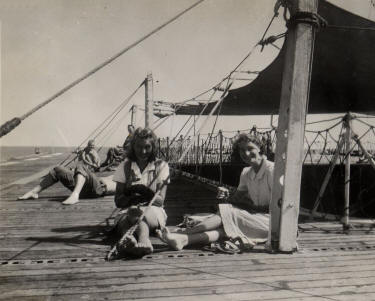 |
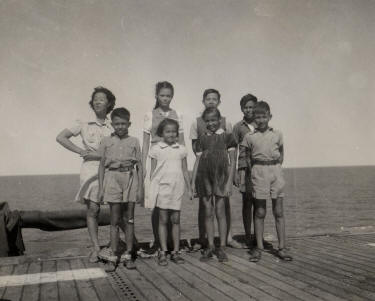 |
September 1945. Left: the voyage out to Hong Kong,
Australian nurses and medical personnel in trhe shade on
the flight deck. Right Refugee children on passage to
Sydney from Hong Kong and Singapore Note the Bofors gun
in the background is encased in its peacetime covers.. Photos: Richard Webb
collection |
From Hong Kong STRIKER sailed for Singapore, where she embarked more recovered Australian POWs and a number of medically unfit but walking POWs transferred from the Hospital Ship
GERUSALEME on September 27th. STRIKER escorted by QUADRANT, re-crossed the equator on the 2nd October 1945 and called at Manus the following day. She arrived back in Sydney on October 9th 1945 and berthed at Pyrmont Wharf to disembark her passengers to the Red Cross clearing centre. Return to the United Kingdom. On completion of unloading STRIKER began a period of defect rectification (yard unknown).
Return to the United Kingdom
On leaving dockyard hands STRIKER began loading stores, equipment and passengers for passage home via Brisbane, Singapore, Colombo, Aden, Port Said, Malta, and Gibraltar. She sailed from Sydney on October 26th for Brisbane where she was berthed at Brett's Wharf, at Hamilton, Brisbane to load stores, and aircraft, including a number of Sea Otters, for ferrying to the UK. She sailed for Singapore on the morning of November 5th.
At Singapore she disembarked some of her passengers and embarked others for onward passage. She sailed from Singapore on November 24th bound for Colombo. She arrived on the Clyde on December 16th 1945. Upon her arrival on the Clyde STRIKER was removed from active service. Under the terms of the agreement through which she was loaned to the Royal Navy she was to be paid for or returned; STRIKER was not to be retained.
Once her passengers and cargo were disembarked many of her crew went home for Christmas leave; many leaving the ship for the last time as only a steaming party would be required to make her final Atlantic crossing. Next work started to de-store the ship and to remove Admiralty equipment in preparation for returning her to the US Navy.
Disposal: return to US custody January 1946
HMS STRIKER departed from the Clyde on her final voyage on January 29th 1946. On arrival at U.S. Naval Base Norfolk, she was decommissioned and CVE-19 was returned to US Navy custody on February 12th 1946. She was struck from the US Navy List on March 28th 1946, and laid up in reserve. She was sold June 5th 1946 to the Patapsco Steel Scrap Co., of Bethlehem, Pennsylvania and was broken up for scrap in 1949.
Notes
[1] It is unclear when 824 NAS disembarked from, and
re-embarked in, STRIKER during her time with the Home Fleet. Some
commentators give dates that put them ashore at times when STRIKER
was at sea on operations, and incident reports of flying accidents
indicate aircraft were on board. Therefore this account assumes they
remained embarked from April 21st 1944 until May 9th 1944.
Content revised:
02 February 2024
Sources used in compiling this account:
Click here for a list of
Primary sources
Additional sources:
The contribution of the British Pacific Fleet to the assault
on Okinawa, 1945. - The London Gazette Of Tuesday, the 1st of
June, 1948
Fold3.com various documents including;
Admiralty War Diaries
Mare Island Navy Yard War Diaries
US Thirteenth Naval District War Diaries
Norfolk Navy Yard War Diaries
Mew York Navy Yard War Diaries
Naval Base, Manus War Diaries
CTF 37 (British) Report of air & surface strikes against the
Japanese empire, preparation for and initial occupation of
the Tokyo bay area, Honshu, Japan. 6/28/45 to 9/2/45
|
Home
page |
go to the top
|
Comments (5)
I would love to receive any email-able photos of the care or ship from anyone who has them.
Interesting that some of the enquiries on here are from Australia - did some of the crew stay in Oz when the carrier returned to Blighty? :-)
Regards
Paul Reeves